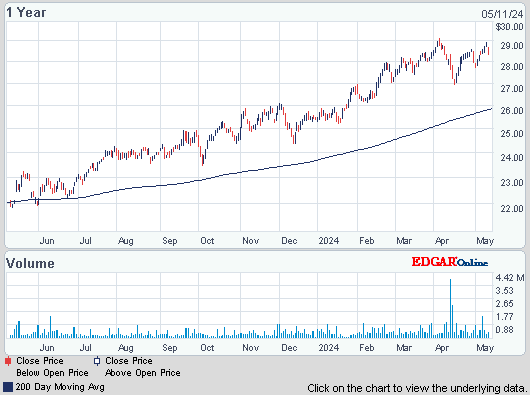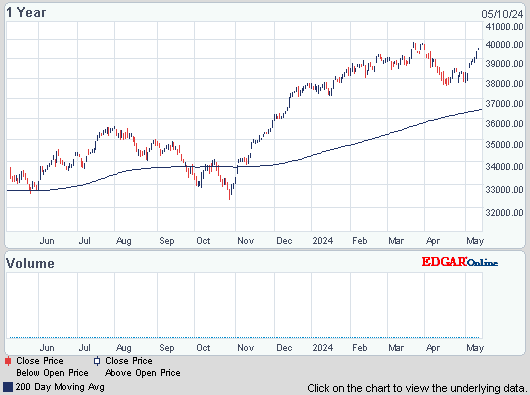Dow fell 89 (closing at the lows), decliners over advancers 2-1 & NAZ was off 34. The MLP index slumped 5 to 463 & the REIT index was up pennies in the 282s. Junk bond funds were mixed & Treasuries saw selling. Oil climbed above $101 on expectations
that cold weather in the US & steady Chinese growth will underpin
demand. Gold was hit with profit taking after its run this year.
AMJ (Alerian MLP Index tracking fund)

Federal Reserve policy makers plan to soon change their guidance for the path of interest rates as unemployment declines toward a threshold for considering an increase in borrowing costs, minutes of the Jan meeting showed. “Participants agreed that, with the unemployment rate approaching 6.5 percent, it would soon be appropriate for the Committee to change its forward guidance in order to provide information about its decisions regarding the federal funds rate after that threshold was crossed,” according to the record of the meeting. “Several” policy makers also said that in “the absence of an appreciable change in the economic outlook, there should be a clear presumption in favor of continuing to reduce the pace” of the bond purchases $10B at each meeting. They are seeking to provide clarity on their plans for continuing to support the economy, both with low interest rates & dwindling bond purchases, after unemployment dropped last month to 6.6%, the lowest in more than 5 years. The minutes of the meeting show officials divided on how to clarify their guidance. “Some participants favored quantitative guidance along the lines of the existing thresholds, while others preferred a qualitative approach that would provide additional information regarding the factors that would guide the Committee’s policy decision,” the minutes said. Several participants said that risks to financial stability should be included in their statement, & others argued the guidance should “give greater emphasis” to keeping rates low if inflation remains “persistently” below 2%.
Fed to Change Rate Guidance as Unemployment Falls, Minutes Show
US Producer Prices increased in Jan, led by gains in food & pharmaceuticals. The 0.2% advance followed a 0.1% rise the prior month, according to the Labor Dept. The estimate called for a 0.1% increase. Over the past 12 months, wholesale prices rose 1.2%. Today’s data mark the debut of the PPI after its first major overhaul since 1978, which more than doubles its reach of the economy by including prices received for goods, services, gov purchases, exports & construction. The lack of pipeline pressures, one reason inflation is running below the Federal Reserve's target, has given policy makers room to keep borrowing costs low to spur growth. The revamped PPI encompasses 75% of the economy, up from 1/3 of all production for the old index, which reflected the costs of goods alone. Since services represent the biggest part of the economy, the gauge will offer a better look at inflation at the producer level & its scope will be similar to the gov indices of prices paid by American consumers. Goods will account for about 24% of the new PPI gauge, while services, including financial services, food wholesalers & transportation providers, make up 63%. Prices received from gov purchases & exported goods represent 11% & construction is 2%. Wholesale prices excluding food & energy climbed 0.2%, exceeding the projected 0.1% advance. The year-to-year advance in Jan was up from a 1.1% gain in the 12 months to Dec. Excluding food & energy, the index increased 1.3% in the 12 months ended in Jan, following a 1.2% year-to-year gain in Dec.
Revamped Wholesale Prices in U.S. Increased 0.2% in January
Photo: Bloomberg
Developed nations are voicing support for the withdrawal of US monetary stimulus & signaling emerging markets will have to cope with the fallout as best as they can. German Chancellor Angel Merkel's administration sees US monetary normalization as necessary. The comment echoes Australian Treasurer Joe Hockey, who in Feb 13 likened Federal Reserve (FED) bond purchases to a drug that the world can’t rely on forever. Market upheaval caused by reduced FED stimulus is shaping up as a central theme for a G-20 meeting in Sydney this weekend. Policy makers in developing markets have been forced into emergency steps as investors sold off currencies, stocks & bonds after the FED decision to scale back asset purchases. India's central bank Governor Raghuram Rajan last month warned of a breakdown in global coordination due to the tapering. Former FED Chairman Paul Volcker said in Seoul this week that the impact of tapering won’t be as bad as markets fear & that stimulus won’t be withdrawn quickly. Still, former World Bank President Robert Zoellick said in Seoul today there will be greater differentiation among developing countries once the FED begins tapering in earnest. This year will be tricky for the world economy, he said.
Merkel Joins Developed Nations Backing Fed Taper Before G-20
It looks like the FED will continue reducing the monthly bonds purchases for the rest of the year, something the bulls don't want to see. This is another reminder how fragile the stock market rally has been, dependent on low interest rates of the FED. Not connected but becoming important, the Ukraine unrest is unsettling to say the least. This activity is associated with a flight to safety by investors. Stocks (bought by those willing to accept risk) are sold & that money goes into safe haven investments (Treasuries & gold). Maybe not today, but look for more of that going forward.
Dow Jones Industrials

AMJ (Alerian MLP Index tracking fund)
Federal Reserve policy makers plan to soon change their guidance for the path of interest rates as unemployment declines toward a threshold for considering an increase in borrowing costs, minutes of the Jan meeting showed. “Participants agreed that, with the unemployment rate approaching 6.5 percent, it would soon be appropriate for the Committee to change its forward guidance in order to provide information about its decisions regarding the federal funds rate after that threshold was crossed,” according to the record of the meeting. “Several” policy makers also said that in “the absence of an appreciable change in the economic outlook, there should be a clear presumption in favor of continuing to reduce the pace” of the bond purchases $10B at each meeting. They are seeking to provide clarity on their plans for continuing to support the economy, both with low interest rates & dwindling bond purchases, after unemployment dropped last month to 6.6%, the lowest in more than 5 years. The minutes of the meeting show officials divided on how to clarify their guidance. “Some participants favored quantitative guidance along the lines of the existing thresholds, while others preferred a qualitative approach that would provide additional information regarding the factors that would guide the Committee’s policy decision,” the minutes said. Several participants said that risks to financial stability should be included in their statement, & others argued the guidance should “give greater emphasis” to keeping rates low if inflation remains “persistently” below 2%.
Fed to Change Rate Guidance as Unemployment Falls, Minutes Show
US Producer Prices increased in Jan, led by gains in food & pharmaceuticals. The 0.2% advance followed a 0.1% rise the prior month, according to the Labor Dept. The estimate called for a 0.1% increase. Over the past 12 months, wholesale prices rose 1.2%. Today’s data mark the debut of the PPI after its first major overhaul since 1978, which more than doubles its reach of the economy by including prices received for goods, services, gov purchases, exports & construction. The lack of pipeline pressures, one reason inflation is running below the Federal Reserve's target, has given policy makers room to keep borrowing costs low to spur growth. The revamped PPI encompasses 75% of the economy, up from 1/3 of all production for the old index, which reflected the costs of goods alone. Since services represent the biggest part of the economy, the gauge will offer a better look at inflation at the producer level & its scope will be similar to the gov indices of prices paid by American consumers. Goods will account for about 24% of the new PPI gauge, while services, including financial services, food wholesalers & transportation providers, make up 63%. Prices received from gov purchases & exported goods represent 11% & construction is 2%. Wholesale prices excluding food & energy climbed 0.2%, exceeding the projected 0.1% advance. The year-to-year advance in Jan was up from a 1.1% gain in the 12 months to Dec. Excluding food & energy, the index increased 1.3% in the 12 months ended in Jan, following a 1.2% year-to-year gain in Dec.
Revamped Wholesale Prices in U.S. Increased 0.2% in January
Photo: Bloomberg
Developed nations are voicing support for the withdrawal of US monetary stimulus & signaling emerging markets will have to cope with the fallout as best as they can. German Chancellor Angel Merkel's administration sees US monetary normalization as necessary. The comment echoes Australian Treasurer Joe Hockey, who in Feb 13 likened Federal Reserve (FED) bond purchases to a drug that the world can’t rely on forever. Market upheaval caused by reduced FED stimulus is shaping up as a central theme for a G-20 meeting in Sydney this weekend. Policy makers in developing markets have been forced into emergency steps as investors sold off currencies, stocks & bonds after the FED decision to scale back asset purchases. India's central bank Governor Raghuram Rajan last month warned of a breakdown in global coordination due to the tapering. Former FED Chairman Paul Volcker said in Seoul this week that the impact of tapering won’t be as bad as markets fear & that stimulus won’t be withdrawn quickly. Still, former World Bank President Robert Zoellick said in Seoul today there will be greater differentiation among developing countries once the FED begins tapering in earnest. This year will be tricky for the world economy, he said.
Merkel Joins Developed Nations Backing Fed Taper Before G-20
It looks like the FED will continue reducing the monthly bonds purchases for the rest of the year, something the bulls don't want to see. This is another reminder how fragile the stock market rally has been, dependent on low interest rates of the FED. Not connected but becoming important, the Ukraine unrest is unsettling to say the least. This activity is associated with a flight to safety by investors. Stocks (bought by those willing to accept risk) are sold & that money goes into safe haven investments (Treasuries & gold). Maybe not today, but look for more of that going forward.
Dow Jones Industrials
I’m a huge fan of INO & from what I have seen so far, their service Marketclub! This isn’t a stripped down version, everything in MarketClub is available to you. I don’t want to give everything away, but you’ll have unlimited access to my favorite 3 tools: Trade Triangles, Smart Scan & Alerts! The best part is that the MarketClub customer support team will be providing UNLIMITED support! You can call or email for an instant response to any question, comment or concern.
Here’s that link:
https://club.ino.com/join/specialtrial/index_free.html?a_aid=CD3289&a_bid=359ef9a3
I’d recommend you jump on this now.









No comments:
Post a Comment